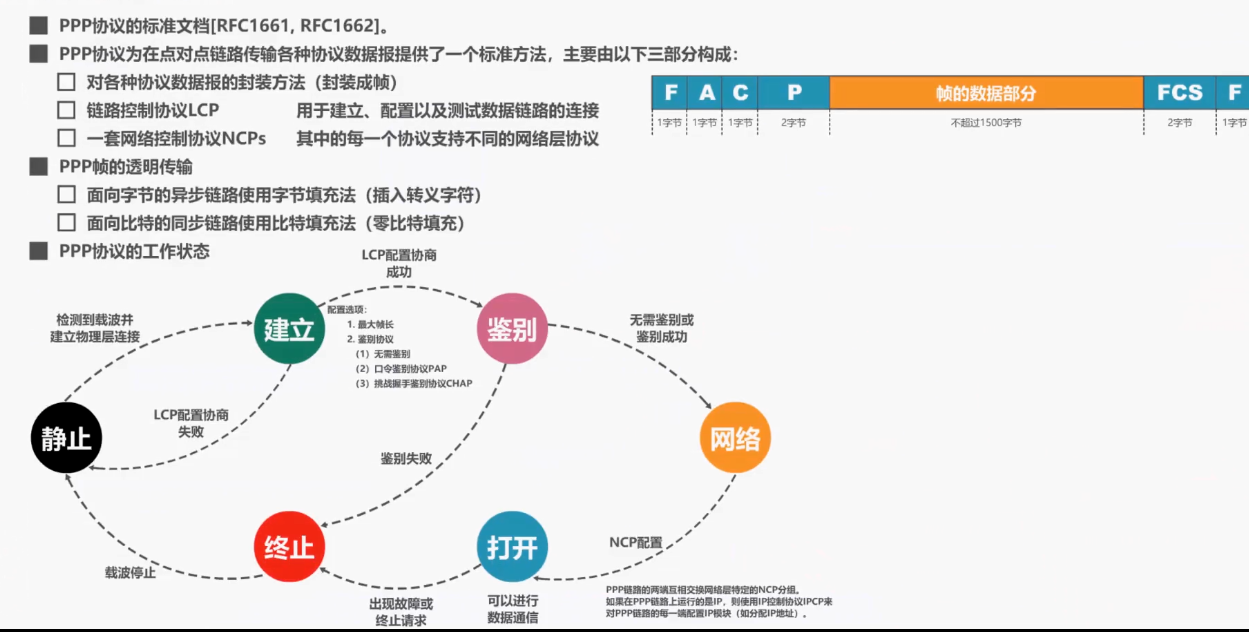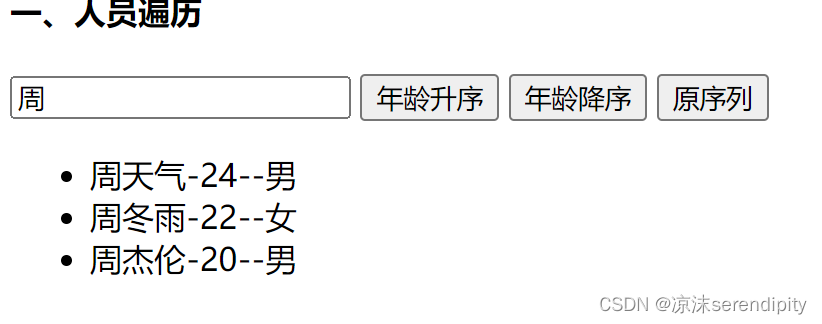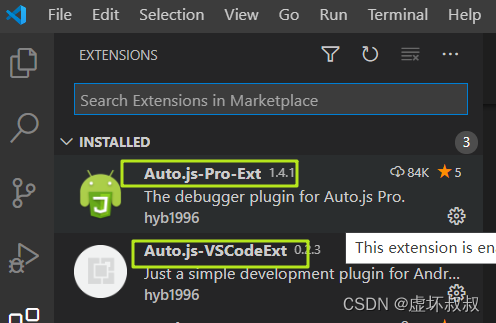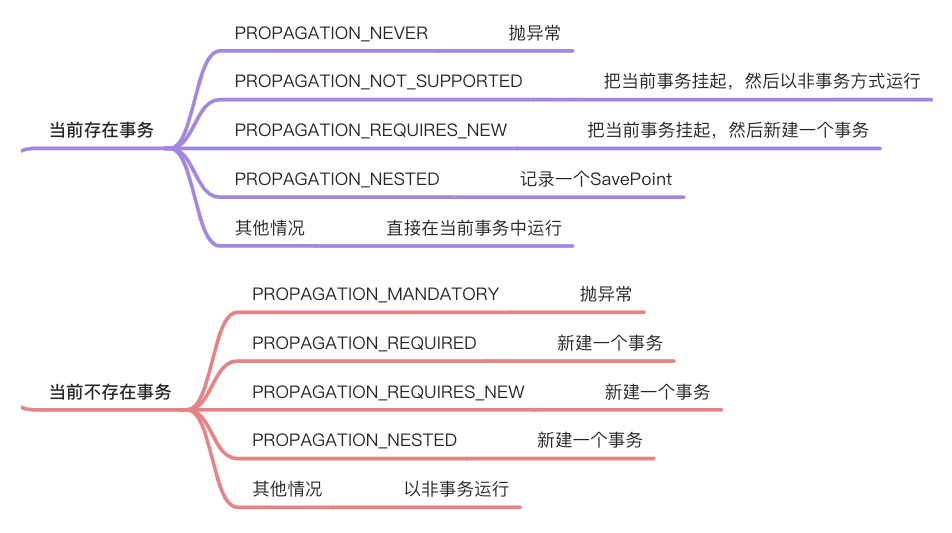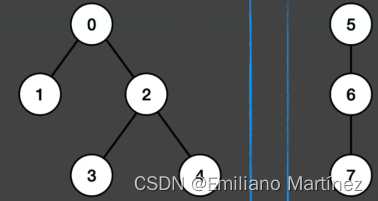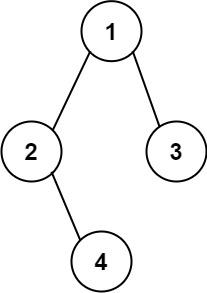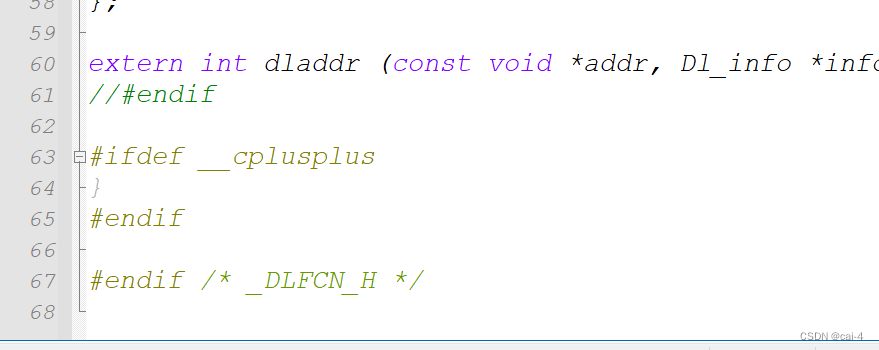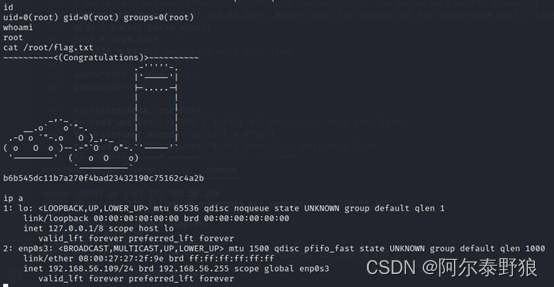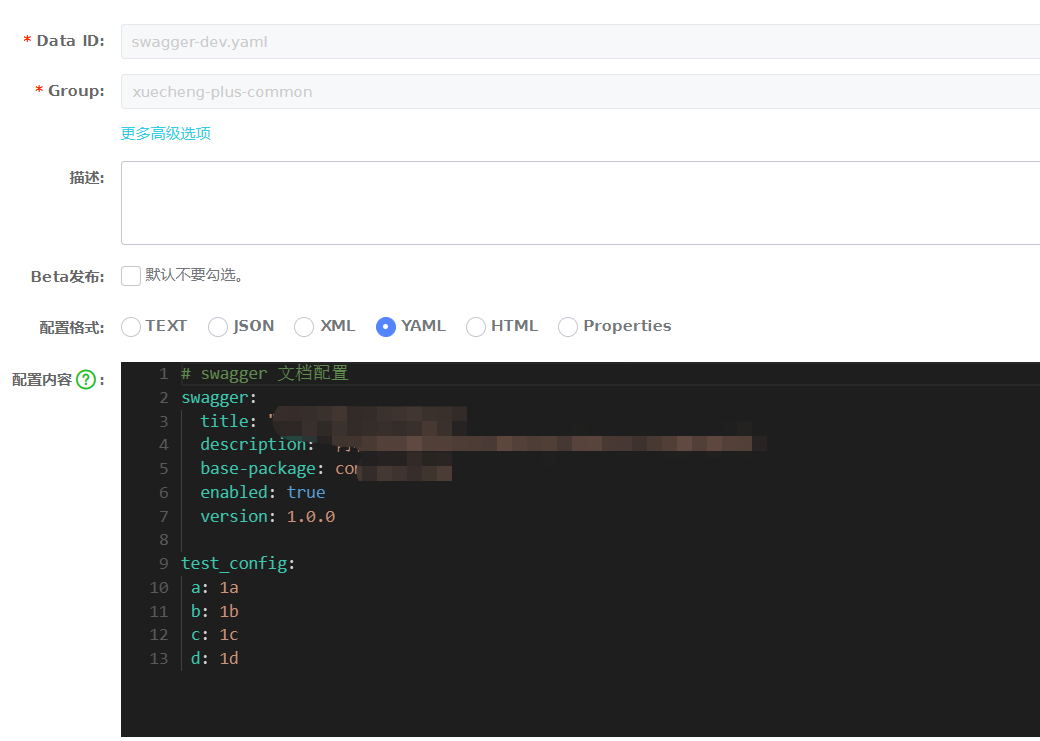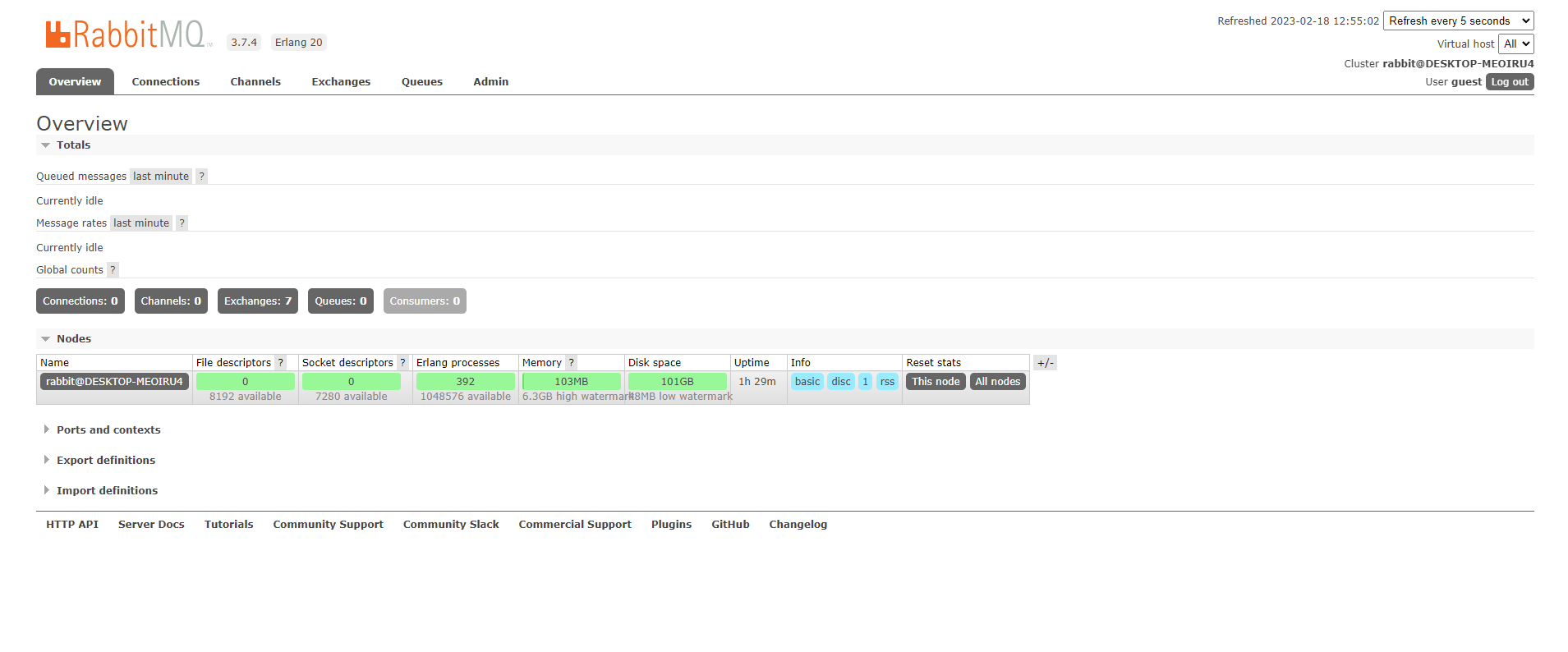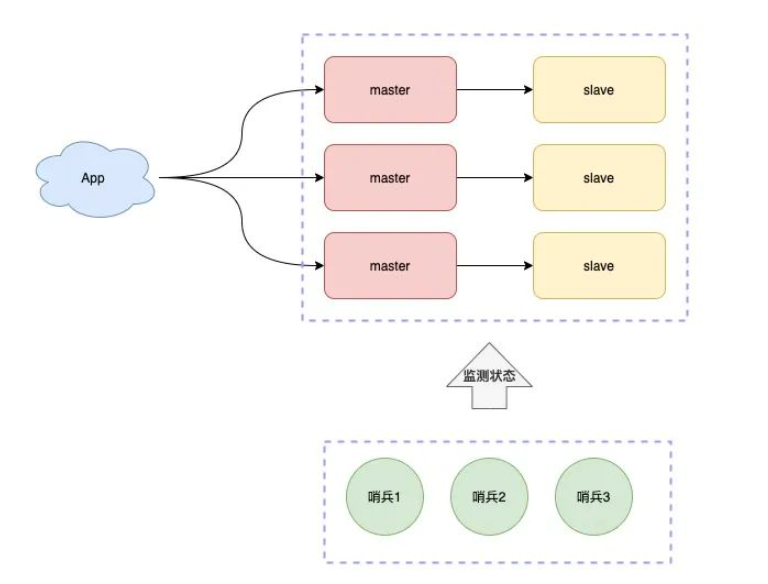
这里写目录标题
- 一、pytest的命名规则
- 二、界面化配置
- 符合命名规则的方法前面会有运行标记
- 三、pytest的用例结构
- 三部分组成
- 四、pytest的用例断言
- 断言写法:
- 五、pytest测试框架结构
- 六、pytest参数化用例
- 1、pytest参数化实现方式
- 2、单参数:每一条测试数据都会生成一条测试用例
- 3、多参数:
- ids:为测试用例起名字
- ids有中文的情况
- 4、笛卡儿积
- 七、标记测试用例
- 八、pytest设置跳过、预期失败用例
- 1、skip的使用场景:
- 2、skipif的使用场景:
- 3、xfail的使用场景:
- 九、pytest运行测试用例
- 1、运行多个测试包
- 2、运行多个测试模块
- 3、运行多个测试类
- 4、运行多个测试方法
- 5、运行单个测试方法
- 6、运行结果分析
- 十、pytest命令行常用参数
- 1、-x:
- 2、--maxfail=2:用例允许失败1条,第2条失败时,stop
- 3、-k:执行测试用例中,包含“tup”的用例(采用双引号)
- 4、-k:执行测试用例中,除了“tup”之外的用例(采用双引号)
- 5、--collect-only:只收集不运行
- 十一、python执行pytest
- 1、使用main函数
- a、pytest.main() :执行当前目录下符合规则的所有测试用例
- b、运行某一条用例
- c、运行某个标签
- 2、使用python -m pytest调用pytest
- 十二、pytest异常处理
- try...except
- pytest.raises()
- 1、捕获异常:意料之内的异常,不会报错
- 2、捕获异常:意料之外的异常,会报错
- 3、捕获多个异常
- 4、捕获异常后获取异常值和异常类型
一、pytest的命名规则
文件: test开头或者_test结尾
类名 : Test开头
方法名 :test_开头
特别注意:测试类中不能定义__init__()方法
二、界面化配置

符合命名规则的方法前面会有运行标记
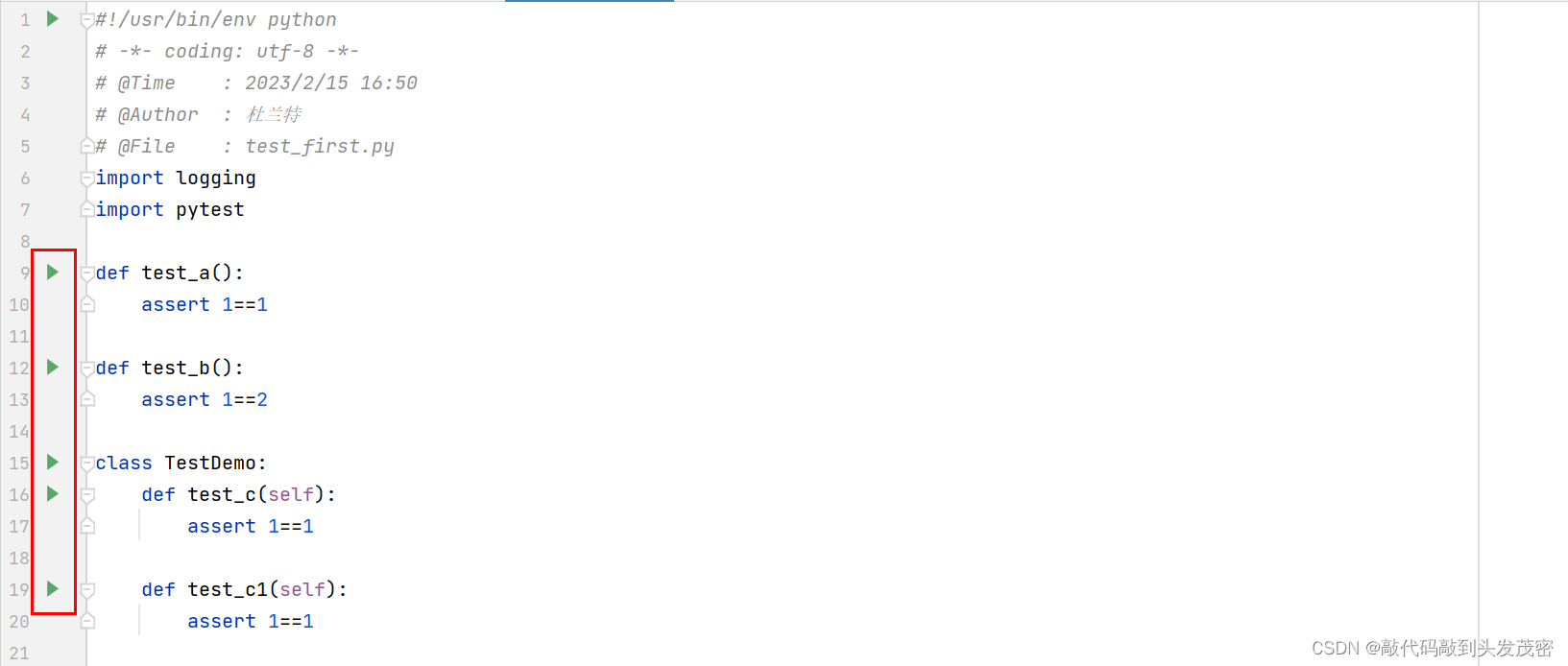
三、pytest的用例结构
三部分组成
用例名称
用例步骤
用例断言
class TestXXX:
def setup(self):
#资源准备
pass
def teardown(self):
#资源销毁
pass
def test_xxx(self):
#测试步骤1
#测试步骤2
#断言 实际结果 对比 期望结果
logging.info('这是xxx测试用例')
assert 1==1
四、pytest的用例断言
断言(assert),是一种在程序中的一阶逻辑(如:一个结果为真或假的逻辑判断式),目的为了表示与验证软件开发者预期的结果。当程序执行到断言的位置时,对应的断言应该为真。若断言不为真时,程序会中止执行,并给出错误信息。
断言写法:
assert 表达式
assert 表达式,描述:当断言成功时,描述语句不会执行;当断言失败时,描述语句会执行。
class TestDemo:
def test_c(self):
assert 1==1
def test_c1(self):
assert 'abc1' in 'abcdef' , 'abc不在abcdef中'
五、pytest测试框架结构
setup_module/teardown_module:全局模块级,只运行一次
setup_class/teardown_class:类级,只在类中前后运行一次
setup_function/teardown_function:函数级别:在类外
setup_method/teardown_method:方法级别,在类中。类中每个方法执行前后
setup/teardown:在类中,在每个测试方法前后执行
六、pytest参数化用例
通过参数的方式传递数据,从而实现数据和脚本的分离
并且可以实现用例的重复生成和执行
1、pytest参数化实现方式
装饰器:pytest.mark.parametrize
2、单参数:每一条测试数据都会生成一条测试用例
#单参数
import pytest
search_list=['appium','selenium','pytest']
# 两组测试数据:两条测试用例
@pytest.mark.parametrize('search_key',['java','appium'])
def test_search_params(search_key):
assert search_key in search_list

3、多参数:
ids:为测试用例起名字
注意:ids 列表参数的个数要与参数值的个数一致
import pytest
#测试数据有2个参数
@pytest.mark.parametrize("username,password",
[["kobe",666],["kd",111],[" ",888]],
ids=['success','fail','username is None'])
def test_login1(username,password):
print(f'登录的用户名:{username},密码:{password}')
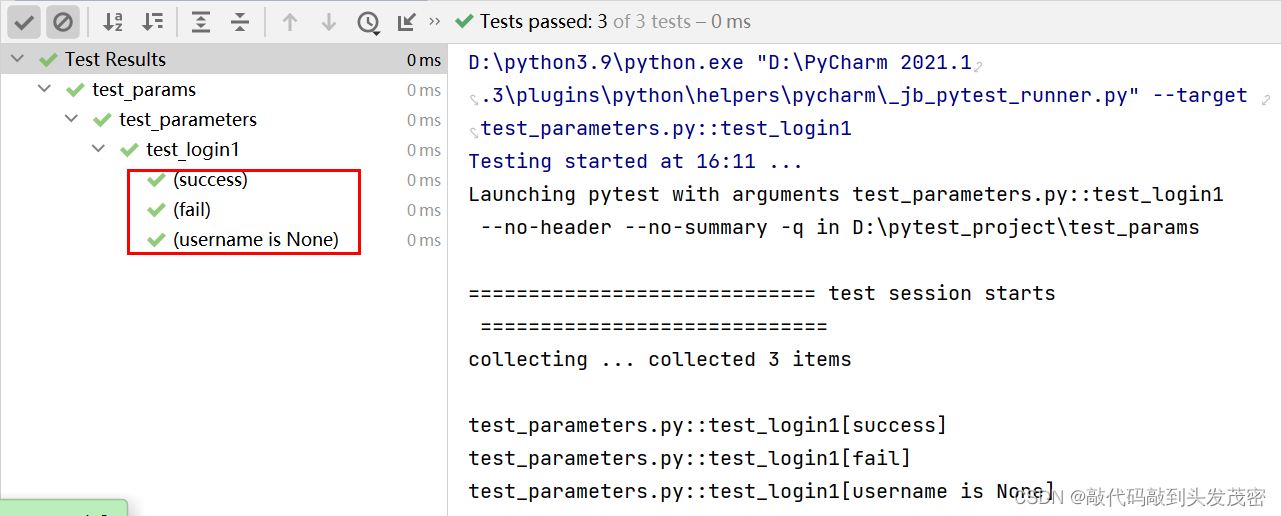
ids有中文的情况
import pytest
@pytest.mark.parametrize("username,password",
[["kobe",666],["kd",111],[" ",888]],
ids=['成功','失败','用户名为空'])
def test_login(username,password):
print(f'登录的用户名:{username},密码:{password}')
需要在conftest.py中定义pytest_collection_modifyitems方法
def pytest_collection_modifyitems(items):
"""
测试用例收集完成时,将收集到的用例名name和用例标识nodeid的中文信息显示在控制台上
"""
for i in items:
i.name=i.name.encode('utf-8').decode('unicode-escape')
i._nodeid=i.nodeid.encode('utf-8').decode('unicode-escape')
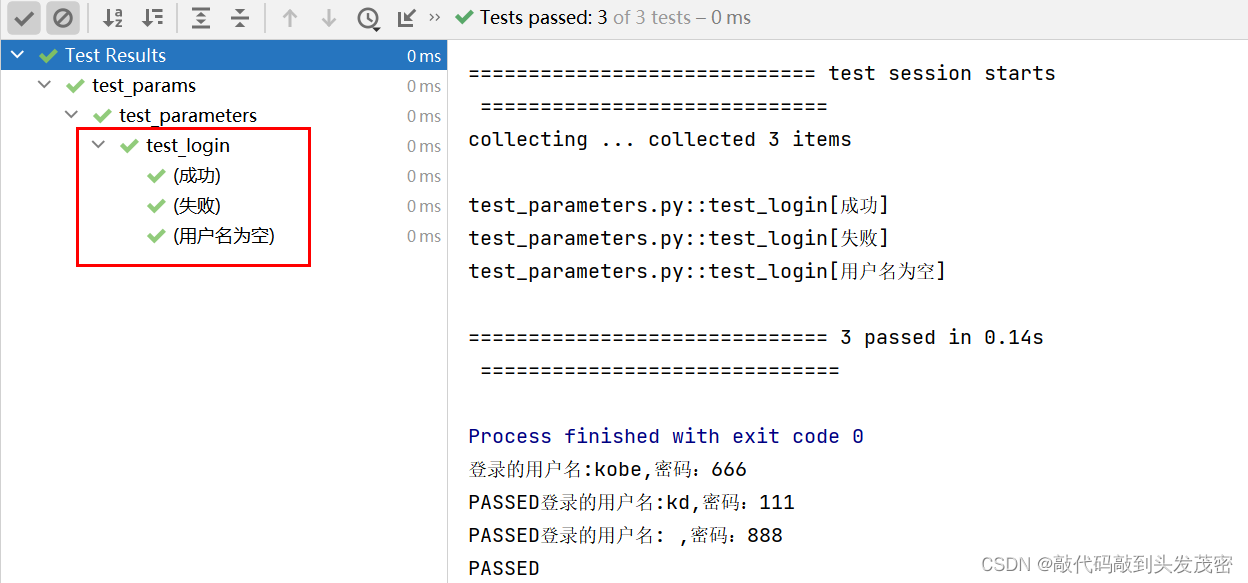
4、笛卡儿积
两组数据a=[1,2,3],b=[a,b,c]
对应的有几组组合形式?
(1,a)(1,b)(1,c)
(2,a)(2,b)(2,c)
(3,a)(3,b)(3,c)
import pytest
@pytest.mark.parametrize('a',[1,2,3])
@pytest.mark.parametrize('b',['aa','bb','cc'])
def test_params1(a,b):
print(f'笛卡儿积形式参数化中,a={a},b={b}')

七、标记测试用例
场景:只执行符合要求的某一部分用例可以把一个web项目划分为多个模块,然后指定模块名执行
解决:在测试用例方法上加@pytest.mark.标签名
执行:-m 执行自定义标记的相关用例
import pytest
#测试数据:整型
@pytest.mark.int
def test_int():
assert isinstance(2,int)
#测试数据:字符串
@pytest.mark.str
def test_str():
assert isinstance('str',str)
#测试数据:浮点型
@pytest.mark.float
def test_float():
assert isinstance('2.7',float)
执行测试用例
D:\pytest_project\test_params>pytest test_mark.py -vs -m int
测试结果
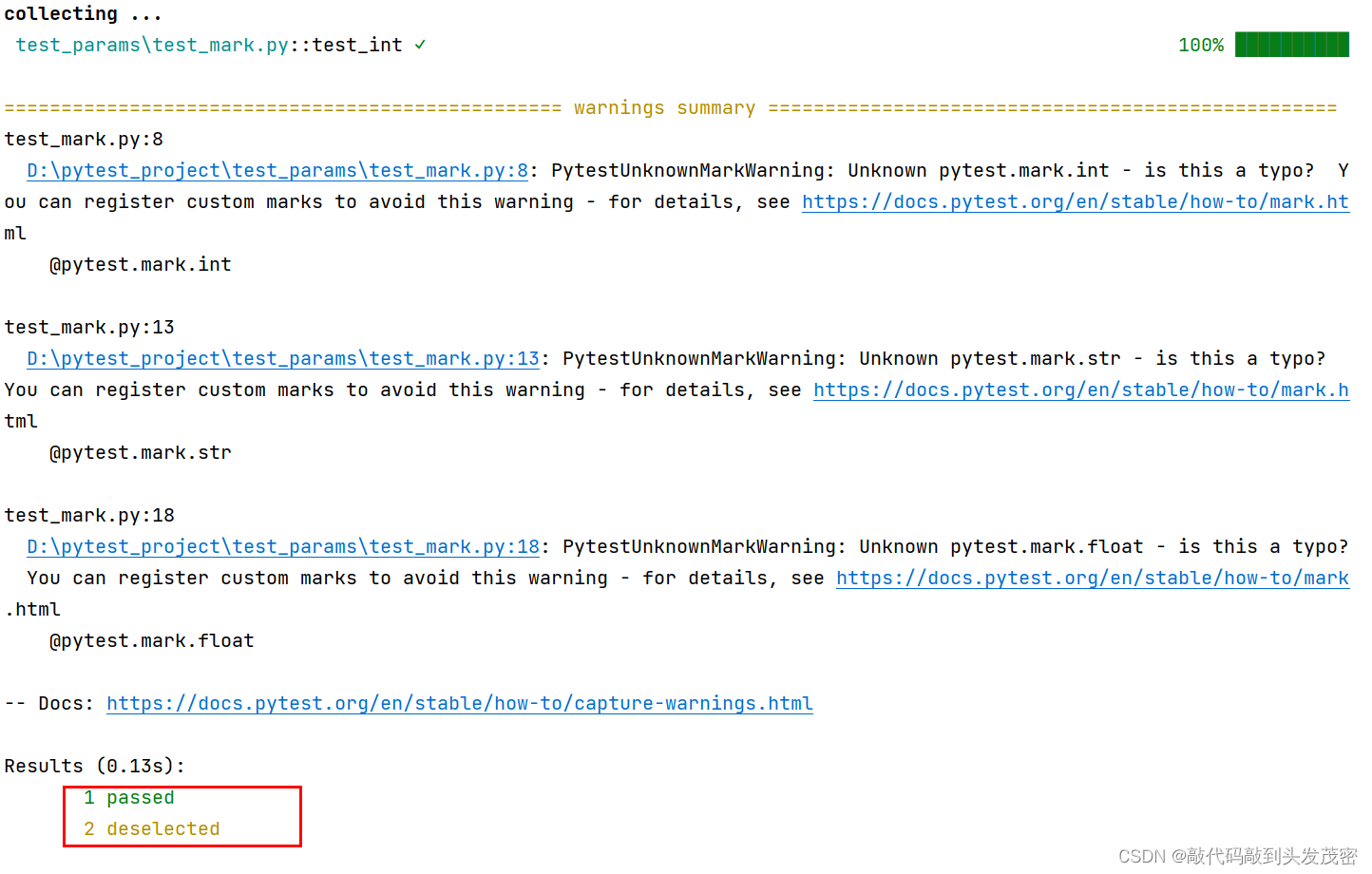
执行用例会出现警告,解决方法:在pytest.ini中将标签注册
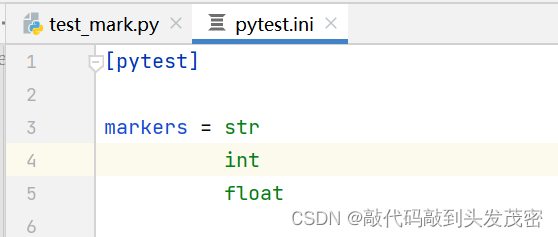
再次执行,没有警告了
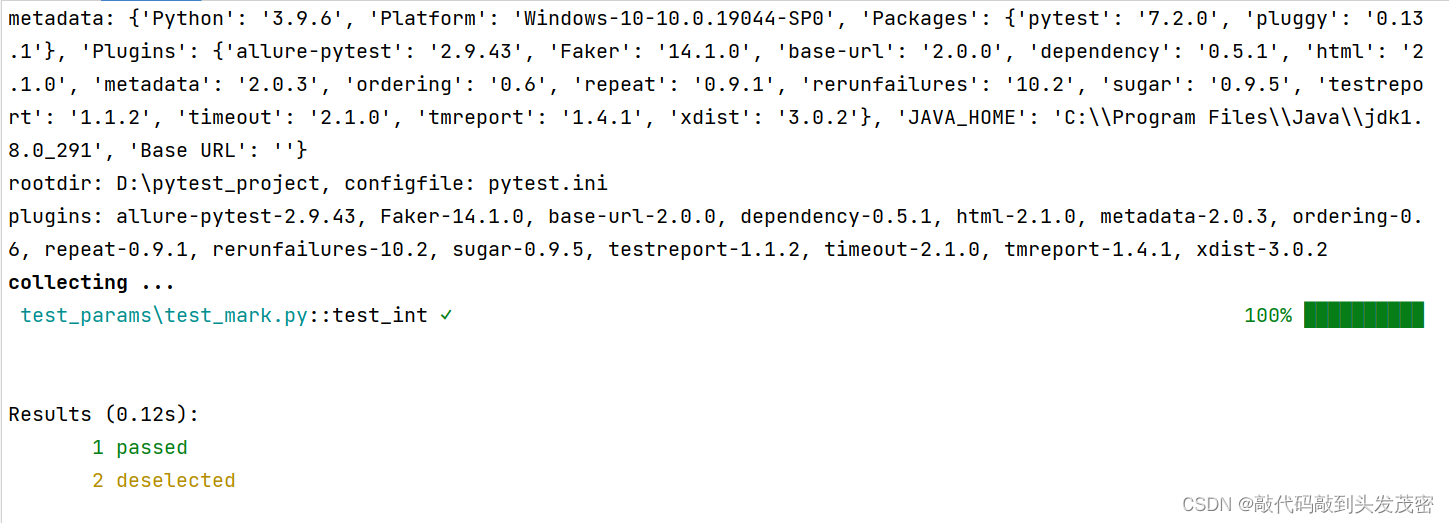
八、pytest设置跳过、预期失败用例
这是pytest的内置标签,可以处理一些特殊的测试用例
skip:始终跳过该测试用例
skipif:遇到特定情况跳过该测试用例
xfail:遇到特定情况,产生一个”预期失败“输出
1、skip的使用场景:
1、调试时不想运行这个测试用例
2、标记无法在某些平台运行的测试用例
3、在某些版本中执行,其他版本中跳过
import pytest
@pytest.mark.skip
def test_aaa():
print("代码未开发完")
assert True
@pytest.mark.skip(reason="代码没有实现")
def test_bbb():
assert False
执行测试用例:测试用例跳过图标默认置灰
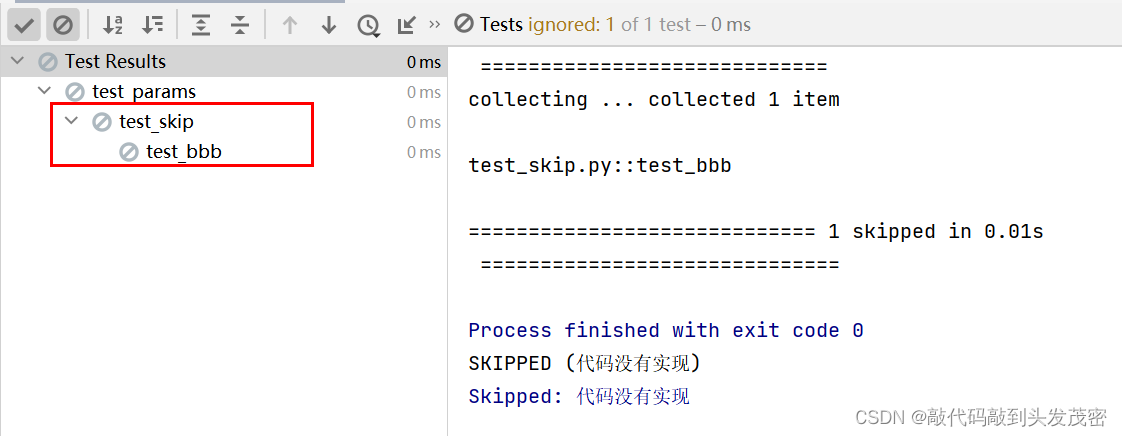
案例:做判断
def check_login():
return False
def test_function():
print("start")
#如果未登录,则跳过后续步骤
if not check_login():
pytest.skip("unsupported configuration")
print("end")
2、skipif的使用场景:
import sys
print(sys.platform)
@pytest.mark.skipif(sys.platform == 'darwin', reason="does not run on mac")
def test_case1():
assert True
@pytest.mark.skipif(sys.platform == 'win', reason="does not run on windows")
def test_case2():
assert True
@pytest.mark.skipif(sys.version_info < (3, 6), reason="requires python3.6 or higher")
def test_case3():
assert True
3、xfail的使用场景:
import pytest
@pytest.mark.xfail
def test_aaa():
print("test_xfail1 方法执行")
assert 2 == 2
xfail =pytest.mark.xfail
@xfail(reason="bug")
def test_hello4():
assert 0
九、pytest运行测试用例
1、运行多个测试包
目录结构
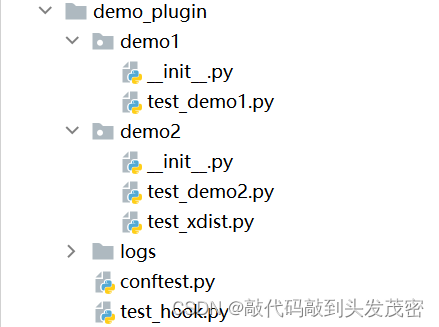
运行测试用例:
D:\pytest_project>pytest demo_plugin
2、运行多个测试模块
运行测试用例:
D:\pytest_project>pytest demo_plugin/demo1
3、运行多个测试类
运行测试用例:
D:\pytest_project>pytest demo_plugin/demo2/test_demo2.py
4、运行多个测试方法
运行测试用例:
D:\pytest_project>pytest demo_plugin/demo2/test_demo2.py::TestB
5、运行单个测试方法
运行测试用例:
D:\pytest_project>pytest demo_plugin/demo2/test_demo2.py::TestB::test_d
6、运行结果分析
常用的:pass(通过)、fail(失败)、error(代码错误)
特殊的:warning(警告,例如pytest.ini中没有注册标签名)、deselect(跳过,加标签skip、skipif)
十、pytest命令行常用参数
-m:执行加标签的测试用例
-k:执行测试用例中包含某个关键字的测试用例(windows中关键字使用双引号)
-x:用例一旦运行失败,立刻停止运行(冒烟测试)
– maxfail=num:测试用例失败达到num个时,立刻停止运行
-v:打印详细信息
-s:打印输出日志
-n:并发执行测试用例
-lf:只执行上次用例失败的测试用例
-ff:先执行上次用例失败的测试用例,再执行其他的测试用例
–collect-only:测试平台,pytest自动导入功能
#!/usr/bin/env python
# -*- coding: utf-8 -*-
# @Time : 2023/2/15 20:10
# @Author : 杜兰特
# @File : test_mark.py
import pytest
#测试数据:整型
@pytest.mark.int
def test_int():
assert isinstance(2,int)
#测试数据:字符串
@pytest.mark.str
def test_str():
assert isinstance('str',str)
#测试数据:浮点型
@pytest.mark.float
def test_float():
assert isinstance('2.7',float)
#测试数据:列表
@pytest.mark.list
def test_list():
assert isinstance('[1,2,3]',list)
#测试数据:元组
@pytest.mark.tuple
def test_tuple():
assert isinstance('(1,)',tuple)
1、-x:
D:\pytest_project\test_params>pytest test_mark.py -x

2、–maxfail=2:用例允许失败1条,第2条失败时,stop
D:\pytest_project\test_params>pytest test_mark.py --maxfail=2
3、-k:执行测试用例中,包含“tup”的用例(采用双引号)
D:\pytest_project\test_params>pytest test_mark.py -k "tup"

4、-k:执行测试用例中,除了“tup”之外的用例(采用双引号)
D:\pytest_project\test_params>pytest test_mark.py -k "not tup"
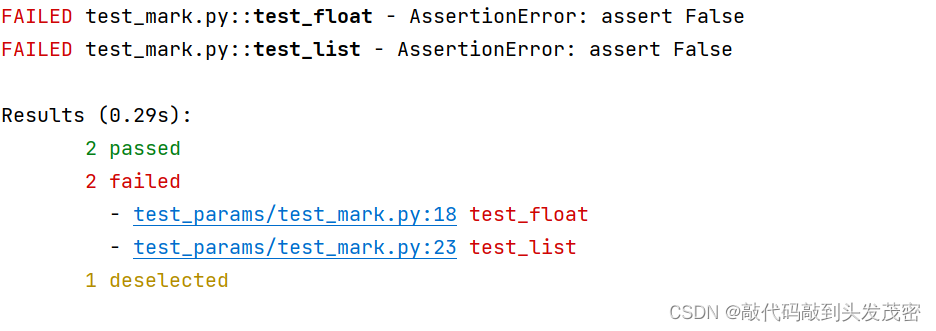
5、–collect-only:只收集不运行
十一、python执行pytest
1、使用main函数
a、pytest.main() :执行当前目录下符合规则的所有测试用例
test_first.py文件
import pytest
def test_a():
assert 1==1
def test_b():
assert 1==2
class TestDemo:
def test_c(self):
assert 1==1
def test_c1(self):
assert 'abc1' in 'abcdef' , 'abc不在abcdef中'
class TestXXX:
def setup(self):
#资源准备
pass
def teardown(self):
#资源销毁
pass
def test_xxx(self):
#测试步骤1
#测试步骤2
#断言 实际结果 对比 期望结果
assert 1==1
if __name__ == '__main__':
pass
#todo 1、运行当前目录下所有的用例
pytest.main() #相当于pytest.main(['./'])
执行测试用例
D:\pytest_project>python test_first.py
b、运行某一条用例
import pytest
if __name__ == '__main__':
#todo 2、运行test_parameters.py::test_login中的某一条用例
pytest.main(['test_params/test_parameters.py::test_login','-vs'])
执行测试用例
D:\pytest_project>python test_first.py
c、运行某个标签
import pytest
if __name__ == '__main__':
#todo 3、运行某个标签
pytest.main(['test_params/test_mark.py','-vs','-m','int'])
执行测试用例
D:\pytest_project>python test_first.py
2、使用python -m pytest调用pytest
D:\pytest_project>python -m pytest test_first.py
十二、pytest异常处理
try…except
pytest.raises()
可以捕获特定的异常
获取捕获的异常的细节(异常类型、异常信息)
发生异常,后面的代码将不会被执行
1、捕获异常:意料之内的异常,不会报错
import pytest
def test_raise():
with pytest.raises(expected_exception=ValueError, match='must be 0 or None'):
raise ValueError("value must be 0 or None")
2、捕获异常:意料之外的异常,会报错
def test_raise1():
with pytest.raises(expected_exception=ValueError, match='must be 0 or None'):
raise ZeroDivisionError("除数为0的")
3、捕获多个异常
def test_raise2():
with pytest.raises(expected_exception=(ValueError,ZeroDivisionError), match='must be 0 or None'):
raise ZeroDivisionError("value must be 0 or None")
4、捕获异常后获取异常值和异常类型
def test_raise2():
with pytest.raises(ValueError) as exc_info:
raise ValueError("value must be 42")
assert exc_info.type is ValueError
assert exc_info.value.args[0] == "value must be 42"


